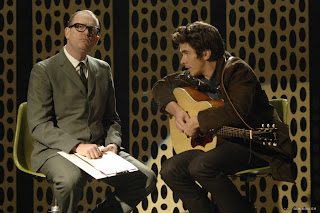
When is a biopic not a biopic? The answer is when it’s Todd Haynes’ examination of the life and experiences of Bob Dylan in I’m Not There. Dylan is one of, if not, the greatest songwriter of all time. As well as writing some of the greatest songs ever sung, Dylan’s life has seen the singer go through many different personas. After emerging as the great poster boy of 60’s folk music, enlightening a generation to social problems, alienating a great many of his folk fans by switching to electric guitar, to his ‘rebirth’ as a Christian, Dylan’s life would make for a pretty packed straight biopic. But Haynes departs from the conventional biopic and presents Dylan’s many personas through a number of different characters. This is not Walk The Line.
As mentioned, I’m Not There concentrates on six different characters, each of which personify either Dylan at a different time of his life, or an aspect of his life. Firstly we have Marcus Carl Franklin who plays an eleven year old boy by the name of Woodie Guthrie (after the folk singer and inspiration for the real Dylan) who travels the south in box cars, singing songs and spouting wisdom far beyond his years. Christian Bale plays Jack Rollins, a protesting folk-singer who turns his back on music in favour of devotion to God. Heath Ledger is Robbie Clark, an actor who makes his break playing Jack Rollins in a biopic of the singer. Ben Whishaw is Arthur Rimbaud who answers questions in front of what seems to be some sort of panel of agents. Cate Blanchett portrays Jude Quinn, who is the personification of Dylan we’ll be most familiar with. Quinn has just arrived in Britain to hoardes of fans, accusations of selling out, and more drugs than he can handle. And finally, Richard Gere plays Billy the Kid who has turned his back on society to live a life in solitude in some sort of anachronistic version of the old west.

As much an examination of what a biopic is as a study of Dylan’s life, I’m Not there mixes many different styles and techniques as it presents each story. For example, the segment about Jack Rollins is shot as a documentary that is a retrospective of Rollins’ life. Where as, the segment about Jude Quinn is more what would be expected from a conventional biopic. Haynes mixes up the stories and cuts back and forth between each character. The result is we never quite know what time period we’re in, and where things are happening. The Quinn part being the only sure part of the film since that period in Dylan’s career is probably the most famous. We see Quinn’s first live performance using an electric guitar, something that horrifies his fans and spills over to the tour of Britain he undertakes where cries of ‘Judas!’ are heard from the crowd.
In biopics, the performances of the actors portraying the real life person is always going to be under the most scrutiny. Having six actors portray the same person, or an aspect of that person does make for an incredibly interesting experience. Yet it’s not like you spend the film thinking ‘well, that actor is more the Dylan I know than that actor.’ In fact, every performance in the film is excellent, whether it’s one of the six central actors, or a member of the supporting cast. One of the best performances in the film comes from Bruce Greenwood, who plays Keenan Jones, a BBC journalist who personifies all the journalists who attacked Dylan for turning his back on humanity and the plight of his fellow man when he made the change from folk to electric. Greenwood also plays and aged Pat Garrett, the arch nemesis of Billy the Kid, who wants to destroy the town the Kid has come to love after turning his back on his former outlaw life.

However, the performance that is getting the most attention, and deservedly so, is Cate Blanchett, who plays Jude Quinn. Aside from the fact that Blanchett is a woman portraying a man, she also becomes a version of Dylan that is instantly recognisable. Anyone who’s seen Martin Scorsese’s brilliant No Direction Home will recognise what Blanchett has achieved when they see the footage of Dylan in Britain in the 60’s. Not only is Blanchett brilliant at portraying this pastiche of Dylan, she also puts in a brilliant performance of a singer at the height of his fame, and how the excesses, and his own personality are slowly destroying him physically. Blanchett’s scenes with Bruce Greenwood, and the moments with David Cross as beat poet Allen Ginsberg are among the highlights of the film.
It’s needless to say that the soundtrack is fantastic. Haynes doesn’t just go for the instantly recognisable songs from Dylan’s vast catalogue throughout the film. Of course, anyone vaguely familiar with Dylan’s music will recognise some of the bigger hits. However, Haynes also employs a number of artists to cover Dylan’s songs throughout the film. The characters sing Dylan’s songs, but sung by different artists. There are Dylan-sung Dylan songs in there, but by the cover versions add a refreshing twist to the film, and suit the scenes perfectly.
Of course the question begs, is there anything for non-Dylan fans in this film? While I’ll admit, being a Dylan fan, and having knowledge of his life certainly did add something to the film, I think there’s plenty to allow non-fans in. Like I said, I’m Not There is very different to the likes of Walk The Line. It’s certainly a more art-house film, and in no way a conventional biopic. But for someone as enigmatic as Dylan, it’s the perfect way to take a look at his life.
 9/10
9/10



1 comment:
This movie looks too good to be true... I can't wait!
and of course, Happy New Year mate!
Post a Comment